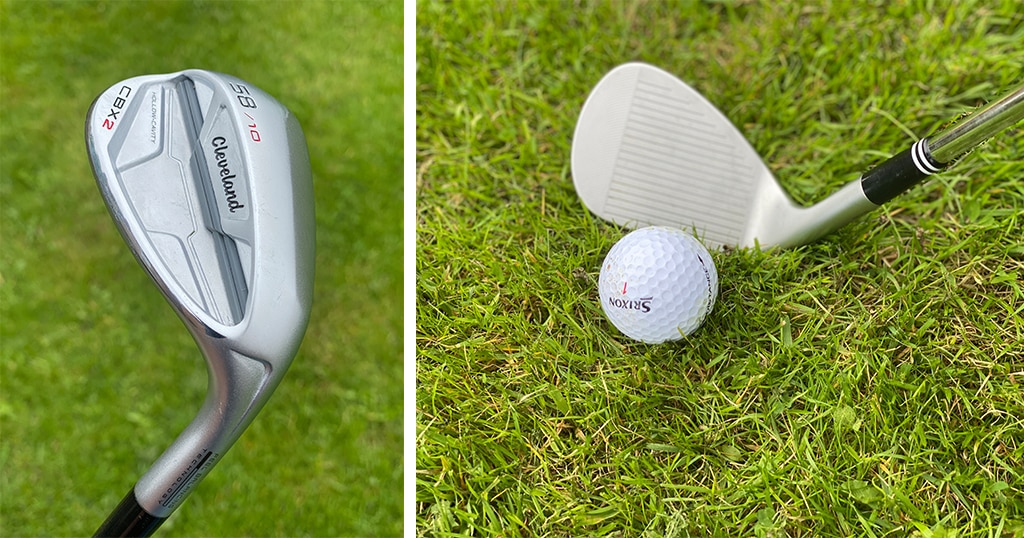After a frustrating round when the driver was working well, but my game inside 100 yards was (seriously) letting me down I decided it was time for a new wedge.
Long story short: after a ton of research I went with a 58 degree Cleveland CBX2. And three rounds in, I’m already seeing a huge difference in proximity to the flag from approaches inside the scoring zone.
Now for the longer story…
I’ll explain why I picked the Cleveland CBX2, and also run through the other wedges I considered.
Update, August 2023: Our top pick for the best wedges for high handicappers is still the Cleveland CBX2.
Cleveland’s latest CBX wedge is the CBX ZipCore. We’re still using the CBX2 as we didn’t consider the changes worth the upgrade for now (generally we wait 2-3 generations), but most of what we mention below about the CBX2 also applies to the ZipCore.
This Year’s Best Wedges For High Handicappers
1. Cleveland CBX2
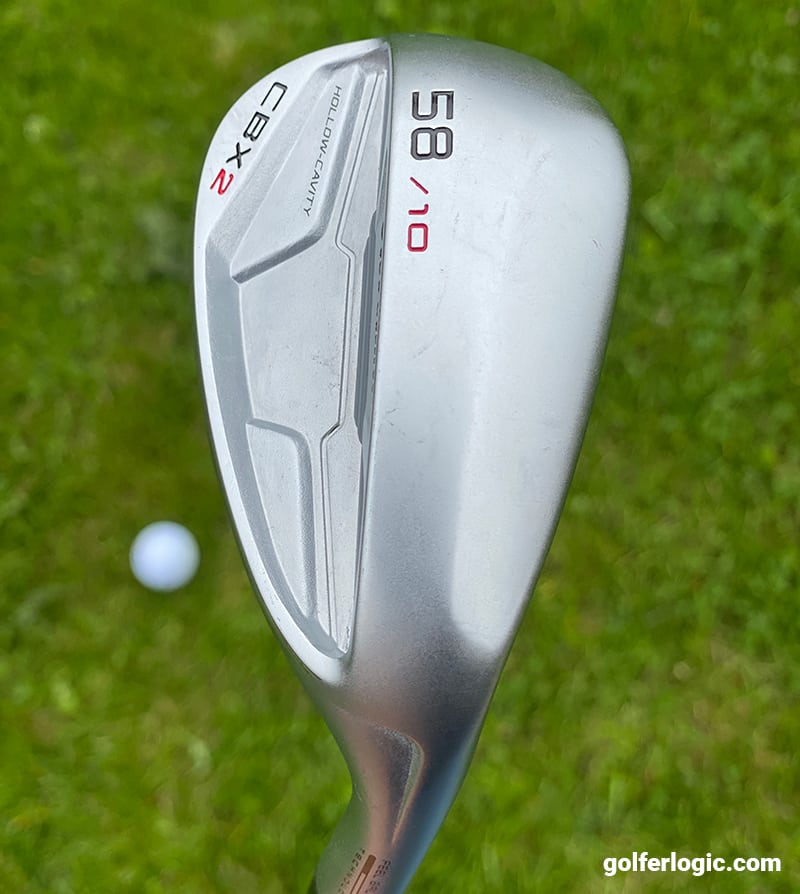
I’m going to go into a bit of detail about why I chose the Cleveland CBX2. And I’ll also run through my experience so far with the wedge.
But there’s one key feature of the Cleveland CBX2 that made me pick it:
It’s one on the best cavity back wedges on the market.
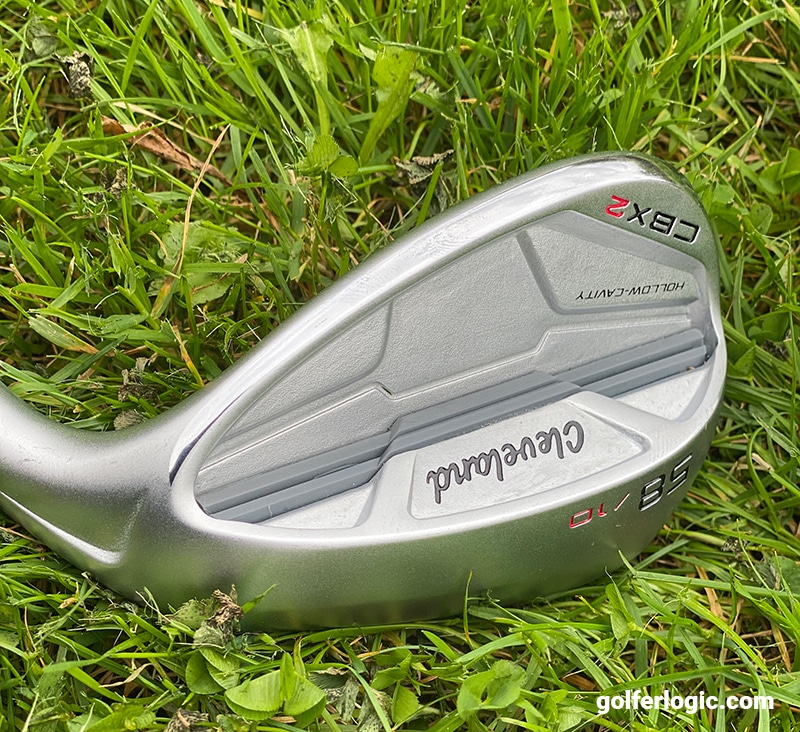
If you’re a mid to high handicapper you should be gaming cavity back irons. In fact, even most single digit players are better off using “game improvement” clubs.
So why is it that when it comes to wedges — arguably the most important clubs for scoring — we’ve all got blades in our bags?
The Cleveland CBX2 wedge on the other hand, looks how we, as mid to high handicappers, expect a golf club to look. Purists may call it ugly. I call it comforting.
It’s never made much sense to me. But I also never really thought to question it. And until my recent purchase I carried a 60 degree Callaway X Grind. When I was hitting it well it was great. But I was forever fearful of the dreaded blade from 50 yards which screams off the face like a driver and sails another 50 yards over the green, deep into the woods and never to be seen again.
And let’s be honest: when you’re scared of what “might” happen, you tense up and it inevitably “does” happen.
You’re used to seeing a cavity back sole at address. So when you look down and see that small, bladed head it’s not exactly confidence inspiring.
The Cleveland CBX2 wedge on the other hand, looks how we, as mid to high handicappers, expect a golf club to look. Purists may call it ugly. I call it comforting.

Why the CBX2 is a better choice than the RTX4 for us mere mortals
When looking for a new wedge I was leaning towards the Cleveland RTX4. It has a ton of great reviews, and I’ve always fancied carrying a Cleveland in my bag.
But then I came across the CBX2 which, with its cavity back, seemed like a better choice for my skill level. I did however have concerns. Was there a reason that wedges tend to be blades?
This video from National Club Golfer allayed my fears…
Graeme McDowell, who is a Cleveland flag bearer, tested both wedges side-by-side. And he was happy with the feel of the CBX2, the look of it address, and interestingly actually hit it closer with the CBX2 than with the RTX4.
If a US Open winner was impressed with the CBX2, then any snobbery on cavity back wedges on my part should definitely be set aside.
On the course: Gaming the Cleveland CBX2 wedge
I dove in at the deep end with my new CBX2 wedge. While I hit some wiffle balls in my office the day before my round, I didn’t have a chance to hit the range, so the first time it was used in anger was on the course.
What I found is that with a relaxed, easy swing, 75-80 yards was the optimum yardage.
I noticed an immediate difference to my approach shots. And so did my playing partner who remarked that “the first bounce is different”. While I’m not going to claim that they were ripping back, there was definitely a considerable increase in spin compared to my old wedge and it would be very much a (short) hop and stop from full swing approaches.
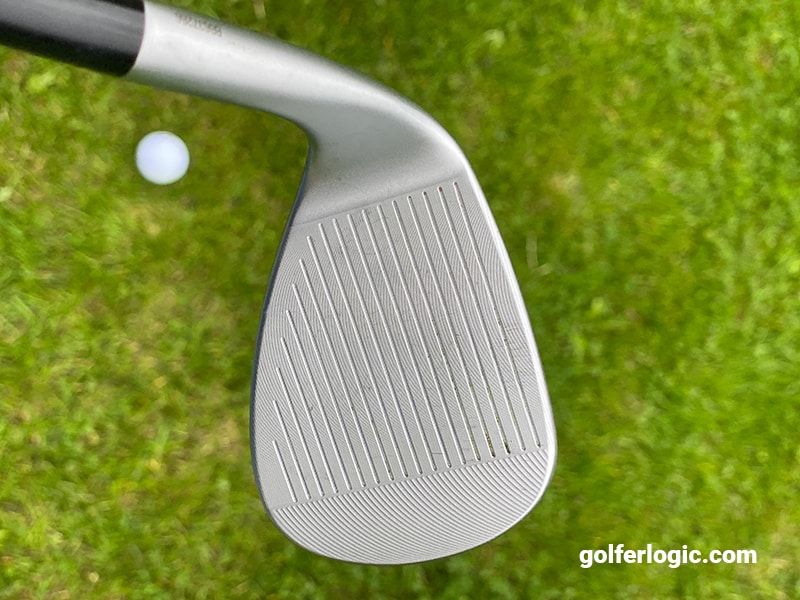
I should point out now (as I’m about to discuss I went with a 58 degree Cleveland CBX2) that I opted for a 58 degree CBX2. My pitching wedge is 46 degree and my sand wedge is 52, so I figured this would give me the best gapping.
What I found is that with a relaxed, easy swing, 75-80 yards was the optimum yardage. Interestingly though, my sand wedge is normally around 100-105 yards (carry) and I could get the CBX2 (with 6 degrees more loft) to go about the same with a more aggressive swing. Generally though we shouldn’t be trying to nuke our wedges — they are finesse clubs — so I’d say for me I’d be using the 58 degree up to 90 yards.
My natural shot shape is a draw (miss being a hook), but I’d say the ball flight here was very straight. Generally I’ll aim right of the pin to give myself a bigger margin of error, but after a few approaches I was confident aiming at the flag. The highlight was sticking one to two feet from 80 yards.
Inside 50 yards I also noticed a big difference. It felt like I could literally try and “throw” the ball at the flag (with a low trajectory) and it would land and stick. Proximity to the hole was hugely improved and I would guess I’d be saving myself 3 or 4 shots around easily.
Around the green: chipping with the Cleveland CBX2 wedge
For the first two rounds I didn’t chip with the CBX as I still hadn’t been able to hit the range to practice. I also prefer to chip with less loft and let the ball run to the hole.
But on the third round I decided to give it a go (it was a very casual affair).
The first couple of chips I left way short (probably because I’m used to more run out). But after that I was getting more comfortable being aggressive through the ball and trying to fly it to the hole with a shorter run out. Certainly there were no problems with bladed chips and the club was confidence inspiring.

What I did do was hit one chip a little fat (from the fairway). And the good news is the bounce of the club did its thing. The shot was by no means a disaster and just came up a little short. So if you’re someone who sometimes hits a little behind the ball with your chips (not generally my issue) then the CBX2 is going to work pretty well. Of course, this is a sample size of literally one chip… but I know when I’ve hit a fat chip before the result was markedly different. The club didn’t dig at all and as I say, the bounce of the wedge did what it was supposed to do.
Summary: Why The Cleveland CBX2 Wedge Is The Best Choice For High Handicappers
As high handicappers we want a wedge that’s going to be easy to launch, fly straight, check on the green, and is going to have an element of forgiveness on both off center hits and slight fats. The Cleveland CBX2 has all of this in spades, plus it’s a cavity back which inspires confidence. Which is why, if you’re a mid to high handicapper, the Cleveland CBX2 should be your next wedge.

…As high handicappers we want a wedge that’s going to be easy to launch, fly straight, check on the green, and is going to have an element of forgiveness on both off center hits and slight fats. The Cleveland CBX2 has all of this in spades
The Cleveland CBX2 is available to buy here.
Now let’s take a look at the other contenders.
2. Ping Glide 4.0
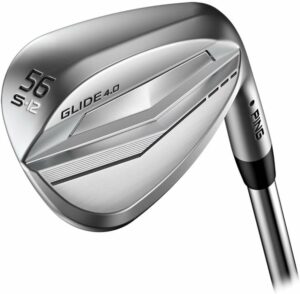
My driver is Ping, my irons are Ping. So Ping seemed like the obvious choice for me when it came to a new wedge. And I was sorely tempted by the Ping Glide 4.0.
The Ping Glide 4.0 wedge looks more like a “player’s” club than the Cleveland at address, however, Ping have included a ton of tech to make this a good choice for high handicappers.
And it is also technically a cavity back wedge. The weighting is designed to give the Ping 4.0 a lower launch with higher spin, which is probably a good thing for those of us who tend to present a little too much loft at impact.
For the 2023/2024 season, the Ping 4.0 is one of the best wedges for beginners, as the Glide has improved feel, spin and therefore consistency, inspiring confidence at address.
Unlike many golf wedges designed for low to mid handicappers, the Glide 4.0 wedge provides a soft and consistent feel. That’s partly due to the 8620 steel body, with a bigger than ever elastomer CTP insert. The new club face means you’ll get 36% more face contact than models a few generations old.
You’ll have 4 different grind options: S, W, T and E. S grind will give you a lead edge that’s round as well as a hint of trail edge and heel relief. The W grind is going to be the most forgiving golf wedge in the 4.0 range with a rounded lead edge, perfect for shots from the bunker. T grind is what you need for a decent lead edge bounce and E grind with its high toe and tapered hosel means bunker shots for high handicappers are improved.
There are a ton of reviews on Ping’s website, most saying that the Ping 4.0 is great from tight lies, and generally easy to hit. And there was also good feedback on check on the green (again, it’s a hop and stop).
If I hadn’t gone for the Cleveland, I would probably have opted for the Ping 4.0. It looks like a great wedge for high handicappers and beginners.
3. Callaway CB
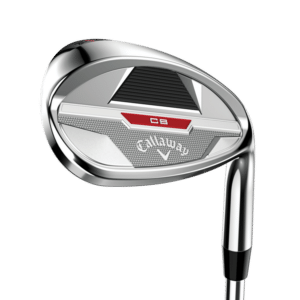
Callaway are known as a club brand producing some of the most forgiving golf wedges on the market, which is exactly what you’ll need if you’re a beginner or high handicapper.
Whilst a lot of golfers consider the Callaway Sure Out 2 to be one of the most forgiving wedges this season, there is another option and one that we prefer; the Callaway CB. We feel this is the wedge you need if you’re a beginner or high handicapper, to help add consistency to your game and progress.
In comparison to a lot of other golf wedges aimed at beginners, you’ll get a decent size face area, not to mention a larger sole. And this is exactly what’s needed to provide consistency at impact. The CB wedge might offer more accurate shots at times, but it’s also more punishing too.
If you’re a Callaway fan looking for their most forgiving wedge for beginners and high handicappers, you won’t go far wrong with the Callaway CB wedge.
4. Cleveland RTX6 ZipCore

I opted for the confidence inspiring cavity back of the Cleveland CBX2. But if you simply must have a blade in your hand, and you want to game the best wedge on the market (for all skill levels), then the Cleveland RTX6 ZipCore should be your choice.
And it was going to be mine until I stumbled on the CBX2, then watched the video with Graeme McDowell comparing the clubs.
One thing I would say here is that it probably depends what type of high handicapper you are. Because for me, it’s my short game that normally lets me down and I’m pretty good from the tee (and with my mid to long irons). But if you’re the opposite, and your short game is solid, then perhaps you don’t need the cavity back.
That’s actually a common misconception with mid to high handicappers, that we suck at all aspects of the game. And most of the time, that isn’t true.
That’s actually a common misconception with mid to high handicappers, that we suck at all aspects of the game. And most of the time, that isn’t true. In my case, I can keep up with scratch golfers until I get to within 50 yards, but then it becomes a different story. Which is why I wanted a wedge that would make this part of the game easier.
The CBX2 does that for me, but if you’re confident with your wedges (and like more workability), then the RTX6 might be a better choice for you. Either way, you’re going to have one of the best wedges in the world in your hands.
In comparison to the old Cleveland CBX2 I use, you’ll get more friction during shots with the RTX6 Zipcore. And that’s thanks to their HydraZip infusion. Dry conditions? There’s a good chance you don’t notice the difference between the two. Damp under foot? You’ll feel the difference during impact between them.
Put simply, it’s one of the best wedges for beginners and high handicappers.
FAQ: Golf Wedges for Beginners & High Handicappers
Which is the best wedge for beginners and high handicappers?
We pick the Cleveland CBX2 we covered here. Or if you prefer the new model, the Cleveland ZipCore.
How many wedges does a high handicapper need?
You’ll be able to survive with a pitching and sand wedge (so, 2). But if you’re in need of a little extra help, go for 4 wedges by including a lob and gap wedge in your golf bag.
What degree wedge should beginners carry?
Typically, beginners and high handicappers will carry a 56 degree wedge.
What’s the easiest wedge to hit around the green?
A gap or pitching wedge is the most consistent club to use around the green for beginners and high handicappers.
What degree wedge do I need as a beginner?
Choosing a wedge should be based on your current club setup. You don’t want big jumps in the loft from your irons to your wedges. You should see a jump of around 4 degree loft for each club as you go from irons to wedges.
What is a 52 degree wedge called in golf?
A 52 degree wedge in golf is commonly referred to as a gap wedge.
Ready To Hit It Closer?
That wraps it up for our round up of the best wedges for high handicappers in 2020.
I went for the Cleveland CBX2, but all of the wedges on our list are solid choices.
Pick one of these for your next wedge and you’ll be sure to start hitting it closer and lowering your scores!
Check out our guide to the best drivers for high handicappers here.

